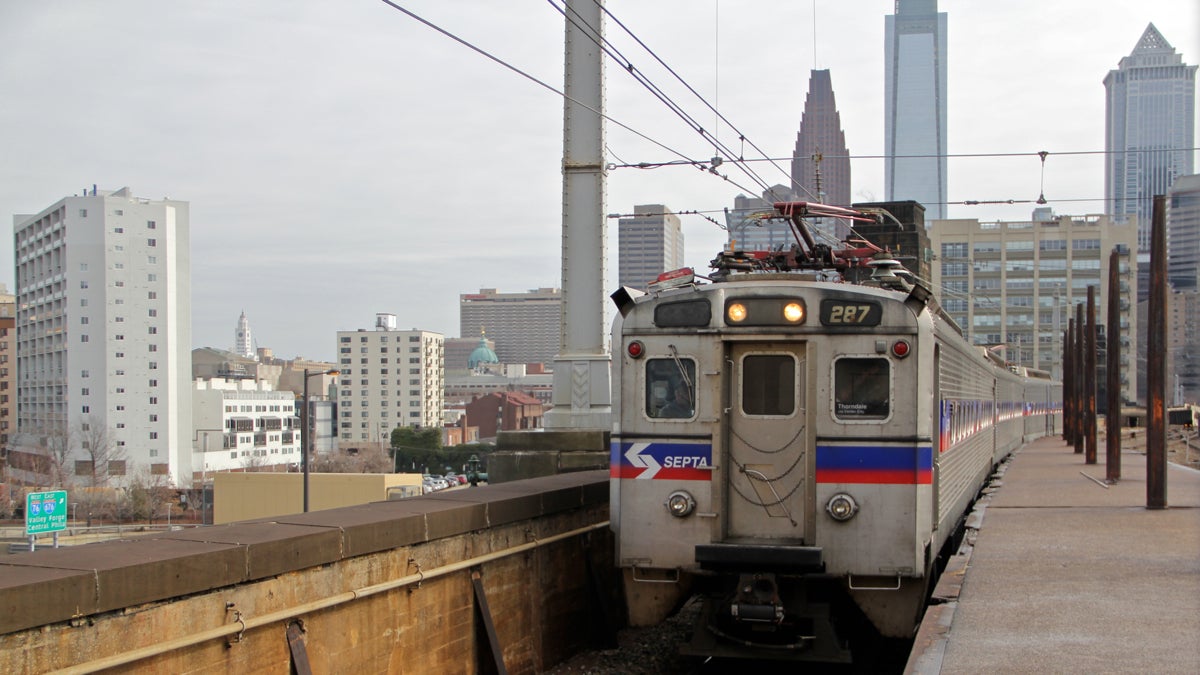Climate change is messing with your commute, SEPTA says after storms halt trains
Most scientists concur that climate change is causing more severe and more frequent storms –– and transit agencies like SEPTA are struggling to keep up.

SEPTA regional rail train. (Emma Lee/WHYY)
Thousands of SEPTA riders were stranded during Wednesday’s powerful thunderstorms. The storm triggered flash flooding and sent trees careening into catenary wires. Buses were diverted.
Norristown High Speed Line and trolley tracks wound up underwater, and a quarter of all the agency’s commuter trains that day were delayed.
The agency had braced for the storm, deploying “rescue buses” near vulnerable lines. But General Manager Jeff Kneuppel said the speed and intensity of the storm still caught his crews off guard.
He called it one of the “top five or ten” worst storms he’d seen in 30 years at the transit provider. But he’s seen a growing number of record-breaking storms in recent years.
“There was four inches of rain that I saw in some areas, falling in a very short period of time. So the flooding was challenging, as were the trees coming into [the] lines,” he said. “These are the kind of disruptive storms we see more and more every year.”
Drexel engineering professor Franco Montalto says that’s not just Kneuppel’s imagination. Most scientists concur that climate change is causing more severe and more frequent storms –– and transit agencies are struggling to keep up.
“To SEPTA riders I would say: Climate change is real,” he said. “Scientists have been predicting these types of impacts for some time now with a high degree of certainty. And we’re starting to see now that the pattern is changing.”
As trapped moisture is released by global warming, it filters into the atmosphere and reappears as intensified rainfall, said Montalto, who also directs the North American hub of the Climate Change Research Network. And that means riders should expect more service disruption.
Kneuppel said SEPTA is aware of the problem and is working to adapt. The agency is upgrading rain signals and placing them on stilts to enhance flood resistance. The agency is also moving away from its reliance on commercial power generation to minimize outages. Prepping rescue buses ahead of weather events is now a standard practice, and the agency is working to improve customer service to better notify customers of delays.
But there are big challenges, particularly for commuter rail and trolley lines. Trains can’t simply be redirected around trouble spots, like the many downed trees seen in the wake of Wednesday’s storm.
The age of systems, like SEPTA, is also a factor. Montalto also said many older lines were historically placed in areas that were otherwise undevelopable –– often low-lying areas, near waterways. The West Trenton Line, which was particularly impacted on Wednesday, is still reliant on electrical substations that date to the 1930s.
“We have a contract out and are replacing those systems, but it obviously didn’t help us,” Kneuppel said. “When you’re manipulating equipment from the 1930s, it’s not as easy to pinpoint where problems are.”
Montalto said transit agencies were also investing in improved drainage systems. But while local decision making was important, it was only one piece of a global puzzle.
“Hopefully, events like these become a wakeup call to take climate change seriously. And to not just adapt but to mitigate and curtail our emissions so we limit how far these changes will go,” he said. “Climate change should be impacting all of our decisions.”
Agencies like SEPTA can be a tool for reducing emissions, but only if they’re functional. Although the rail system was back in action by Thursday morning, Kneuppel said more frequent and unpredictable storms still take a toll on riders, his staff and emergency crews.
“It was very difficult to predict what was going to happen…It was rough,” he said. “We continue to work hard to improve our resiliency. And the way the weather seems to be moving, we have to.”
WHYY is your source for fact-based, in-depth journalism and information. As a nonprofit organization, we rely on financial support from readers like you. Please give today.







